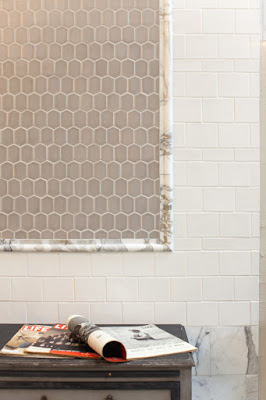In this post, we’ll explore the various types of home styles and some tile designs and installation techniques that work for each:
Craftsman
Craftsman houses originated in the early 1900s. When these houses are renovated, homeowners typically wish to embrace the artisanship by showing off the actual structure of the home, so the intent is to complement the original features rather than cover them up. To balance the richness of your home's interior, consider neutral palettes such as brown, beige, or dark porcelain tiles. The use of natural stone tile and natural stone mosaics will allow you to maintain a classic look while achieving a fresh appearance. Contemporary homes offer lots of family space.Contemporary
 The 21st century represents the onset of contemporary homes. And when it comes to contemporary, no two homes look alike. Each has a distinct personality. Clean, straight lines are a signature feature of this home style, and acutely angled roofs are common. Inside, contemporary homes offer lots of space for families to spread out and relax. Checkered or solid porcelain tiles with a contemporary design can make the rooms feel even more spacious. In bathrooms, ivory colored subway tiles add a traditional yet modern look. Bold, geometric tiles also work well in this style home.
The 21st century represents the onset of contemporary homes. And when it comes to contemporary, no two homes look alike. Each has a distinct personality. Clean, straight lines are a signature feature of this home style, and acutely angled roofs are common. Inside, contemporary homes offer lots of space for families to spread out and relax. Checkered or solid porcelain tiles with a contemporary design can make the rooms feel even more spacious. In bathrooms, ivory colored subway tiles add a traditional yet modern look. Bold, geometric tiles also work well in this style home.Georgian colonial
These homes have two important sources of inspiration: classical Greece and 1700s Britain. Combining brown brick with tall white pillars, this style of house is imposing, yet homey. Often, Georgian colonial homes feature a perfectly symmetrical design.Repeating your home's exterior symmetry with an equivalent interior design is a great way to create a consistent aesthetic. Natural stone mosaics and porcelain mosaics or ceramic mosaics always look fantastic in a Georgian colonial. Consider stacked, brick, chevron or herringbone patterns in the foyer, kitchen or bathrooms.
Mediterranean
 Mediterranean homes are well known for their natural stone, terracotta, or stucco exteriors, as well as their gigantic windows that let in the sunlight. Modeled after the rustic homes of Italy and the South of France, a Mediterranean home can make you yearn for a vacation or can tempt you to turn your own home into a luxurious paradise.
Mediterranean homes are well known for their natural stone, terracotta, or stucco exteriors, as well as their gigantic windows that let in the sunlight. Modeled after the rustic homes of Italy and the South of France, a Mediterranean home can make you yearn for a vacation or can tempt you to turn your own home into a luxurious paradise. If ever there was a home that called for stone, porcelain and ceramic tile, a Mediterranean home is it. Crisp marble and other natural stones or cool ceramic tiles evoke the feeling of a Venetian hotel you'd never want to leave. In the kitchen, lightly colored porcelain tiles with a wood look catch the sunlight and diffuse it into a warm glow.
Modern
 Modern, or Mid-Century Modern, homes often feature open floor plans designed with fun and entertainment in mind. This style of home can feature a wide variety of materials, with fun shapes, textures and colors.
Modern, or Mid-Century Modern, homes often feature open floor plans designed with fun and entertainment in mind. This style of home can feature a wide variety of materials, with fun shapes, textures and colors.Make your statement with mirrored glass. Or incorporate a bold geometric tile or classic stone mosaic.
Ranch
Ranch-style kitchens often display natural materials. Single-story ranch homes invite the outdoors to come right up onto the front porch. Characterized by open floor plans and large windows, this style home welcomes just about any interior decor. Consider a porcelain tiles with a wood look to complement natural materials used in ranch homes. An earth-toned stone helps to bring the natural colors of a desert inside.Victorian
Victorian homes are ornate inside and out. Often featuring turrets and gabled porches, these homes are anything but plain. Inside, each room has its own distinct personality, as should the walls and floors. Mosaic tile patterns work well in any room of a Victorian home. From miniature curved limestone mosaics to beveled arabesque patterns, you needn't worry about the room feeling too busy. Victorian homes are designed full of curio-cabinets, grandfather clocks and ornate shelving - the tiles should match that unique sense of understated opulence.Now that you have a better understanding of which tile designs match well with various home styles, stop by missionstonetile.com to find the perfect pattern for your house.

























